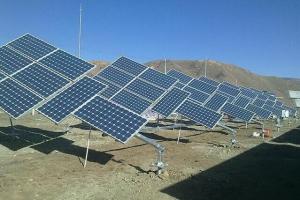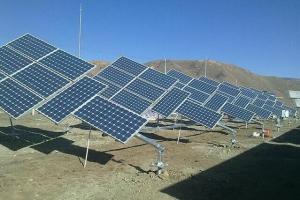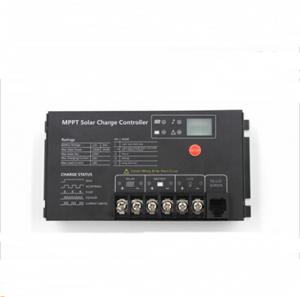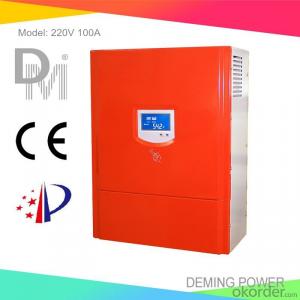MPPT Electronic Controller High Efficiency 45A Good Quality
- Loading Port:
- Shekou
- Payment Terms:
- TT or LC
- Min Order Qty:
- 100 pc
- Supply Capability:
- 100000 pc/month
OKorder Service Pledge
OKorder Financial Service
You Might Also Like
MPPT Electronic Controller High Efficiency 45A
1. MPPT Solar Charger Controller Characteristics:
1. MPPT Solar charge controller 20A,30A,40A
2. MPPT efficiency max 99%,Peak conversion efficiency >98%
3.PV input :100V or 145V max
4.12v/24v auto work
5.DSP processors architecture ensures high speed and performance
6.Four stages charging method
7.Protection :PV arry short circuit ,PV reverse polarity ,battery reverse polarity,over charging ,output short circuit.
2. MPPT Electronic Controller specifications:
| Model | PC16-4515A | PC16-6015A | |
| Default Battery System Voltage | 12V/24V/36V/48VDC (adjustable) | ||
| CONTROLLER INPUT | PV Open Circuit Voltage Range | 16V~100V for 12V battery system/32V~145V for 24V battery system/ 48V~145V for 36V battery system/64V~145V for 48V battery system | |
| Max PV Input Power(12V) | 600W | 800W | |
| Max PV Input Power(24V) | 1200W | 1600W | |
| Max PV Input Power(36V) | 1800W | 2400W | |
| Max PV Input Power(48V) | 2400W | 3200W | |
| BATTERY | Limited charge voltage | 15.5~16.0VDC/31.0~32.0VDC/46.5~48.0VDC/62.0~64.0VDC | |
| Equalizing charge voltage | 15.0~15.5VDC/30.0~31.0VDC/45.0~46.5VDC/60.0~62.0VDC | ||
| Boost charge voltage | 14.0~15.0VDC/28.0~30.0VDC/42.0~45.0VDC/56.0~60.0VDC | ||
| Float charge voltage | 13.2~14.0VDC/26.4~28.0VDC/39.6~42.0VDC/52.8~56.0VDC | ||
| Equalizing charge interval | 3~30day | ||
| Equalizing charge time | 1H~3H | ||
| Boost charge time | 1H~3H | ||
| DC OUTPUT | Output Voltage | 9.8~16.0VDC/19.6~32.0VDC/29.4~48.0VDC/ 39.2~64.0VDC | |
| Peak Conversion Efficiency | 98% (MPPT Efficiency 99%) | ||
| Max Charging Current | 45A | 60A | |
| Warning for low voltage | 11.8VDC/23.6VDC/35.4VDC/47.2VDC(Adjustable) | ||
| Cutoff for low voltage | 9.8VDC/19.6 VDC/29.4VDC/39.2VDC(Adjustable) | ||
| Low voltage recovery | 12.0~13.0VDC/24.0~26.0 VDC/36.0~39.0VDC/48.0~52.0VDC(Adjustable) | ||
| GENERAL SPECIFICATION | Charge mode | MPPT, PWM, constant current-constant voltage, function of automatic protection for storage battery | |
| Radiating mode | Air cooling | ||
| Working mode | Four stage: Absorption CC, Absorption CV, Float CC, Float CV | ||
| Light controlled open voltage | 5V | ||
| Light controlled delay time | 5min | ||
| DISPLAY & PROTECTION | LED indication | Systematic operation, LV indication, LV protection, over charge protection, loads protection, short circuit protection | |
| LCD display | Charge voltage, charge current, voltage of storage battery, capacity of storage battery, output current | ||
| Alarm Protections | PV array short circuit, PV reverser polarity | ||
| Battery reverse polarity, Over charging protection | |||
| Output short circuit protection | |||
| Low voltage protection for storage battery | |||
| MECHANICAL SPECIFICATIONS | Mounting | Wall mount | |
| W*H* D(mm)/G.W(kg) | 170*259*128mm/4.2kg | 170*289*128mm/4.8kg | |
| OTHER | Environmental Rating | Indoor | |
| Operation Temperature Range | -35~45°C | ||
| Ambient humidity | 0~90% relative humidity(non-condensing) | ||
| Altitude | ≤3000m | ||
3. MPPT Solar Charger Controller Production Line:
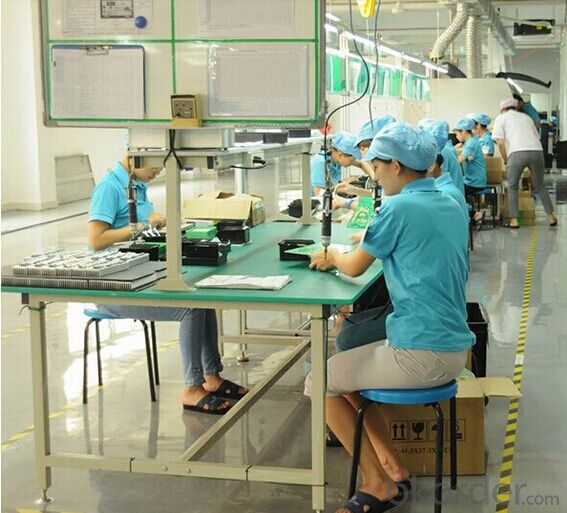
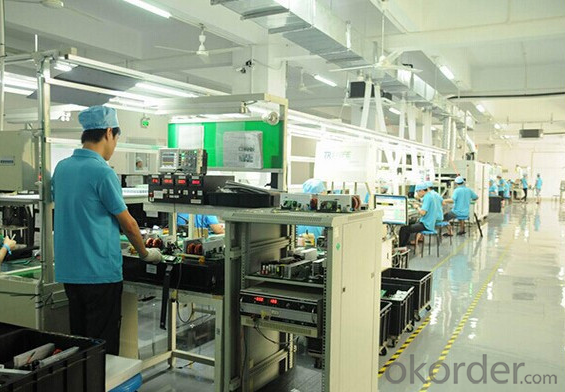
4. MPPT Solar Charger Controller FAQ:
We have organized several common questions for our clients, may help you sincerely:
1. How to choose a right solar controller?
Tell us your demand, then our sales will recommend a suitable one to you.
2. What is the solar inverter warranty?
Our product warranty is valid for 12 months after delivery. We undertake to repair any malfunctioned units due to defective components of inadequate workmanship ,but specially expecting any defects resulting from normal wear and tear of improper use of the products.
3. How long can we receive the product after purchase?
a.sample orders will be delivered from our factory within 7working days .
b.General orders(under 2000pcs) will be delivered from our factory within 25 working days.
c. Bulk orders (over 2000pcs )will be delivered from our factory within 35 working days at most
4. What is the payment term?
T/T (Telegraphic transfer) / Letter of credit
- Q:Can a solar controller be used with solar panel grounding systems?
- Yes, a solar controller can be used with solar panel grounding systems. In fact, it is highly recommended to have a solar controller as part of the overall system. The primary function of a solar controller is to regulate the amount of charge going into the batteries from the solar panels, preventing overcharging and extending the battery life. When it comes to solar panel grounding systems, they are designed to provide a safe path for electrical current in the event of a fault or lightning strike. Grounding systems generally consist of grounding rods, conductors, and bonding connections to ensure that any excess electrical energy is safely dissipated into the earth. The solar controller itself is not directly involved in the grounding system, as its main purpose is to regulate the flow of electricity from the solar panels to the batteries. However, it is important to ensure that the solar panel arrays are properly grounded and bonded according to local electrical codes and standards. To sum up, a solar controller can be used in conjunction with solar panel grounding systems, as they serve different purposes within the overall solar power system. It is crucial to follow the appropriate guidelines and regulations to ensure the safe and efficient operation of the entire system.
- Q:How do I know if my solar controller is working properly?
- To determine if your solar controller is working properly, you can follow a few steps. Firstly, check the LED indicators on the controller. They usually display the charging status and battery level. If these indicators are functioning correctly, it's a good sign that the controller is working. Secondly, monitor the battery voltage regularly. If the controller is functioning properly, it should regulate the battery voltage, preventing overcharging or deep discharging. Lastly, you can use a multimeter to measure the voltage between the solar panels and the battery. If the controller is working effectively, it should show a consistent voltage reading. If you notice any discrepancies or inconsistencies, it's advisable to consult the manufacturer or a professional for further assistance.
- Q:How does a solar controller protect batteries from overcharging?
- A solar controller protects batteries from overcharging by regulating the voltage and current output from the solar panels. It constantly monitors the battery's state of charge and adjusts the charging process accordingly. When the battery reaches its optimal charge level, the controller will reduce or completely cut off the charging current to prevent overcharging, which can lead to damage or reduced battery life.
- Q:How long does a solar controller typically last?
- A solar controller typically lasts for about 10 to 15 years, depending on the quality of the controller and how well it is maintained.
- Q:What is the maximum number of solar panels a solar controller can handle?
- The maximum number of solar panels a solar controller can handle depends on the specific model and its specifications. Different solar controllers have different capacity limits, which are typically measured in terms of the maximum input voltage and current they can handle. It is important to consult the manufacturer's specifications or user manual to determine the exact maximum number of solar panels that a specific solar controller can handle.
- Q:What is the temperature range for a solar controller?
- The temperature range for a solar controller typically varies between -40°C to 80°C.
- Q:What is the maximum power output a solar controller can handle?
- The maximum power output a solar controller can handle depends on its specific design and capacity. It can range from a few watts to several kilowatts, with higher-end controllers capable of handling larger solar power systems.
- Q:Can a solar controller be used in a solar-powered outdoor signage system?
- Yes, a solar controller can be used in a solar-powered outdoor signage system. A solar controller regulates the charging and discharging of the batteries in the system, ensuring efficient and safe operation. It helps to optimize the power output from the solar panels, protect the batteries from overcharging or deep discharging, and increase the overall lifespan of the system.
- Q:What is the maximum charging voltage of a solar controller?
- The maximum charging voltage of a solar controller typically depends on the specific model and its design specifications. However, in general, most solar controllers have a maximum charging voltage of around 14.4 to 14.8 volts for a 12-volt system and around 28.8 to 29.6 volts for a 24-volt system. These maximum charging voltages are set to ensure that the batteries connected to the solar controller are not overcharged, which can lead to damage or reduced battery lifespan. It is important to consult the manufacturer's documentation or specifications for the specific solar controller being used to determine the exact maximum charging voltage.
- Q:Can a solar controller be used with solar panels of different materials?
- Solar controllers can indeed be used with solar panels made from different materials. Their main task is to regulate the flow of voltage and current from the solar panels to the battery or grid, and this function is not affected by the material of the panels. Regardless of whether the solar panels are composed of monocrystalline, polycrystalline, thin-film, or any other material, the solar controller will effectively carry out its duties. However, it is crucial to verify that the solar controller is compatible with the specific voltage and current requirements of the solar panels in use.
1. Manufacturer Overview |
|
|---|---|
| Location | |
| Year Established | |
| Annual Output Value | |
| Main Markets | |
| Company Certifications | |
2. Manufacturer Certificates |
|
|---|---|
| a) Certification Name | |
| Range | |
| Reference | |
| Validity Period | |
3. Manufacturer Capability |
|
|---|---|
| a)Trade Capacity | |
| Nearest Port | |
| Export Percentage | |
| No.of Employees in Trade Department | |
| Language Spoken: | |
| b)Factory Information | |
| Factory Size: | |
| No. of Production Lines | |
| Contract Manufacturing | |
| Product Price Range | |
Send your message to us
MPPT Electronic Controller High Efficiency 45A Good Quality
- Loading Port:
- Shekou
- Payment Terms:
- TT or LC
- Min Order Qty:
- 100 pc
- Supply Capability:
- 100000 pc/month
OKorder Service Pledge
OKorder Financial Service
Similar products
New products
Hot products
Hot Searches
Related keywords
